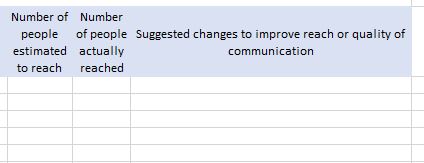
Unless you are in a senior role in the communications group or department you probably never had to make an annual communication plan before. Recently I was asked to help two people (one from a mid-sized and the other from a small company) who never had to make an annual communication plan before but were expected to create one now. Perhaps you are also tasked with making one? Or maybe you are asked to comment on one?
The basic idea behind an annual communication plan is to ensure that someone is planning to address targeted communications activities to various groups of people across all the available platforms that are used by the group or organization. The plan should typically include specific mention of dates, details of the intended contents of messages or specific focus areas, and be specific about who is responsible for each of the actions. That way everyone involved in executing activities from the communication plan is aware of his or her role and when deliverables would be due.
Planning to communicate is not the hard part of the assignment as most people are quite creative during brainstorming sessions related to what we can do and how to do it. The hard part is to write it all down so that we all know what will actually happen after we leave the meeting or brainstorming session. And the next hard part is to apply self-discipline to execute according to the plan and update and review the plan on a regular basis.

The downloadable template above shows various aspects to consider when you look ahead to a year of planned communications. Of course, we know that plans are subject to changes happening around us on the project or changes in the company or in client needs. This means the plan is not static and you should review the plan on a regular basis to add or change items as needed. Remember to share updates you made with other team members who have activities assigned to them.

The first column in the template contains a few communication channels to consider as you look at the messages you want to share and the intended target groups that your messages should reach. Ensure that you are using the right communication channels that you know to be in broad use by your intended target group of readers. And each of the headings could have multiple options for example meetings could be global meetings, regional meetings and local meetings where you would like the same message or a different version of the main message to be shared.

The columns across the top of the template are mainly there to document who is doing what by when and when you are ready to publish and have published or delivered the message. This helps you measure progress on planned activities and shows where you may need to apply special focus to avoid delays.

The published date is important, not only to ensure that your intended actions were completed but also to measure the success of your communication activities after the activity has been completed.
In this simple template, the only measure shown is based on the number of people reached. There are many more ways to measure the outcomes and success of your communication actions including:
- How many people took a further action after reading or watching (if video) or listening to (if podcast) your message (i.e. liked it, clicked on the button for “more information etc),
- How many people used it as a reference or highlighted it by linking to it, sharing it or tagging it,
- How many people visited your website right after you have published or shared a new message?
Add additional columns to your plan (as needed) in order to capture any other important measures that you wish to track per message, date and communication channel.
General tips
- Plan to share the same message in many different ways to optimize the number of times and ways that your intended audiences receive the message during a relatively short timespan.
- Not every communication message can be forecasted and planned over a 12-month period but without at least a guideline of topics that you would like to share over a 12-month period, the chances of missing opportunities to impact your intended audiences are bigger. Remember, you can always update and make changes when unplanned events occur while you progress through your plan.
- Experiment with a mix of ways to communicate – create messages to be shared face-to-face with credible speakers and follow up with something online and perhaps also a film on your website.
- Do use metrics to track results against your goals. It is the best way to know what works and what needs to be improved. Having proven successes also adds credibility to your communication plan and activities.
When tasked with creating an Annual Communication Plan, you may never need to become an expert at creating this kind of plan, yet it is still in your best interests to capture your thoughts about planned communication activities, responsibilities, deadlines, and metrics in a concise way. This template is only one way to achieve this. Once you have created the plan in a structured way people can review it, comment on it and manage to it and it ensures alignment within the team as you make progress with your communication objectives.
